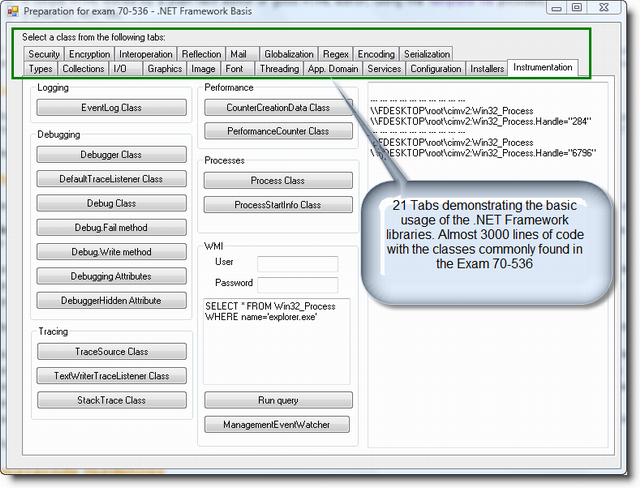Introduction
This article presents a code example with the usage of the basic .NET Framework classes according to the first certification exam 70-536.
When studying for that exam, I found it useful to have all the involved code in one simple file/project for easy debugging. That's why I created this WinForms application with 21 Tabs plenty of examples.

For example, here you can see the tab that allows you to play with the System.Drawing library to draw strings.

Using the Code
If you are planning to take the first exam of the .NET Framework or just learn the usage of the base classes, this is the plan that I suggest:
- Read the official MCTS Self-Paced Training Kit.
- Get at least one of the official recommended test engines and exams suggested by Microsoft.
- Use the code provided in this article to debug each feature and play with the basic classes. Complete any TODO in the code.
- You can also copy the entire code to a Word document and print it in color for easy reference and for studying when you are commuting to the office. I estimate it takes less than 50 pages/almost 3000 lines of code. This will help you remember the classes and the common usage.
- You can print the code and the diagram shown below and place it in a wall like in your office box.
- Find study partners! Engage people in your software factory/office to certify together and meet to discuss. Remember the Latin proverb “By learning you will teach, by teaching you will learn”.
- Find in CodeProject other examples of the missing sections. There are fantastic regular expressions and COM interoperability articles that you should check.
Bonus
I included a PDF with a diagram I made some time ago showing the basic concepts related to Classes, Interfaces and Structs. It is based in the public C# 2.0 language definition. You can print it as is or you can convert it to Word format with any of the utilities available in the network for that purpose or copy the content to the clipboard.
Here I show you just a part of the diagram:

As you will see, the diagram shows only the most relevant particularities of the language like for example "the interface can inherit multiple base-interfaces".
The recommendation is that you play with Visual Studio one more time trying to apply and challenge each "cell" on the diagram and think why that is the way it is.
Points of Interest
You need to understand that the code provided in this article is by no means a replacement for any other official preparation material. This is just a companion "easy to debug, easy to print".
